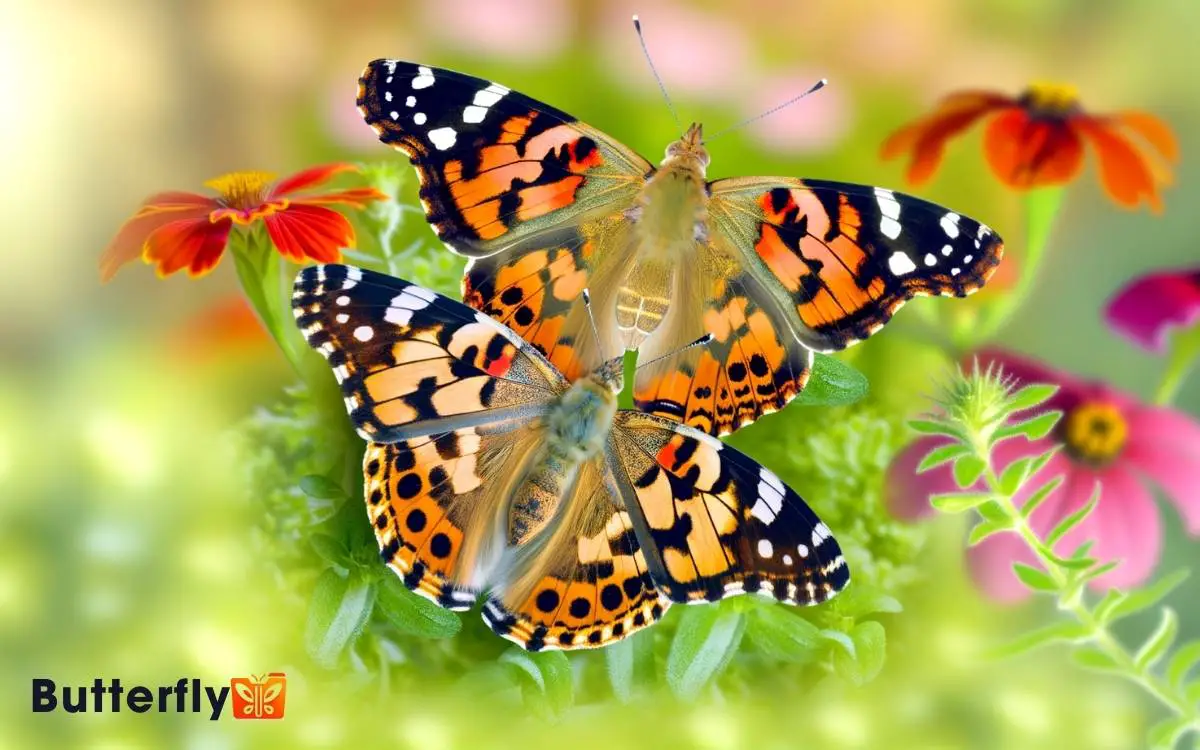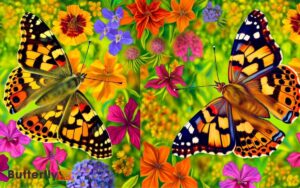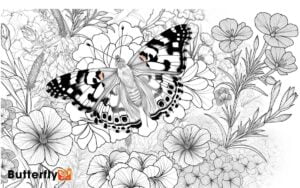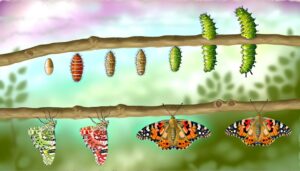American Lady Butterfly Vs Painted Lady: A Comparison!
The American Lady (Vanessa virginiensis) and the Painted Lady (Vanessa cardui) butterflies, both part of the Nymphalidae family, differ in key ways.
The American Lady features larger eyespots on its hindwings and a distinctive white spot on its forewings, while the Painted Lady has smaller, symmetrical eyespots and broader wings.
The American Lady resides mainly in North and Central America and shows less migratory behavior. In contrast, the Painted Lady is cosmopolitan with extensive migration patterns.
Behavioral differences include territoriality in the American Lady vs. a nomadic lifestyle in the Painted Lady. Learn about their ecological adaptations and conservation efforts for a deeper understanding.

Key Takeaways
Taxonomy and Classification
Although they’re often confused with one another, the American Lady (Vanessa virginiensis) and the Painted Lady (Vanessa cardui) are distinct species within the family Nymphalidae.
The American Lady belongs to the genus Vanessa, subgenus Cynthia. It’s closely related to Vanessa annabella, the West Coast Lady.
Conversely, the Painted Lady also belongs to the genus Vanessa but occupies a broader distribution globally, reflecting its adaptability.
Both species fall under the order Lepidoptera, class Insecta, and phylum Arthropoda.
While they’re taxonomically close, their genetic divergence underscores specific evolutionary pathways.
Biologists use mitochondrial DNA and morphological traits to differentiate these species accurately, reinforcing the importance of precise classification in ecological studies and conservation efforts.
Physical Appearance
The American Lady and Painted Lady butterflies exhibit notable differences in their wing color patterns, size, and distinctive markings.
While both species feature orange and black hues, the American Lady has more pronounced white spots on the forewings.
Additionally, the American Lady is generally smaller with a more angular wing shape compared to the broader, more rounded wings of the Painted Lady.
Wing Color Patterns
Upon close examination, one can observe that the American Lady butterfly exhibits distinctively larger eyespots on its hindwings compared to the more uniform and smaller eyespots found on the Painted Lady.
The American Lady displays two prominent eyespots, which serve as a defensive mechanism against predators.
In contrast, the Painted Lady’s hindwings feature several smaller eyespots arranged symmetrically.
Additionally, the American Lady’s forewings possess a unique white spot centered within an orange band, providing a contrast to the Painted Lady’s more consistent orange and black coloration.
These differences highlight evolutionary adaptations that contribute to each species’ survival. By understanding these wing color patterns, enthusiasts can better identify and appreciate the subtle variations between these visually similar butterflies.
Size and Shape
Measuring the physical dimensions and contours, lepidopterists note that the American Lady butterfly generally displays a slightly broader and more angular wing shape compared to the more streamlined and rounded wings of the Painted Lady.
The American Lady typically has a wingspan ranging from 1.75 to 2.25 inches, while the Painted Lady’s wingspan falls between 2 to 2.9 inches. Additionally, the forewings of the American Lady exhibit a more pronounced angle, contributing to its distinctive silhouette.
The table below delineates the key differences:
| Feature | American Lady | Painted Lady |
|---|---|---|
| Wingspan (inches) | 1.75 – 2.25 | 2 – 2.9 |
| Wing Shape | Broader, more angular | Streamlined, rounded |
| Forewing Angles | Pronounced | Subtle |
| Contour | Angular | Smooth |
| Overall Silhouette | Distinctive | More uniform |
Distinctive Markings
In examining the distinctive markings, lepidopterists observe that the American Lady butterfly features two prominent eye spots on the underside of its hindwings, contrasting with the four smaller eye spots seen on the Painted Lady.
The dorsal side of the American Lady displays vibrant orange and black patterns, while the Painted Lady exhibits a more muted palette with intricate web-like black lines.
Additionally, the American Lady’s forewings possess a white spot within an orange patch, an identifier absent in the Painted Lady.
Both species showcase a series of white spots on the tips of their forewings, yet these differ slightly in size and arrangement. Such markings play essential roles in species identification and understanding their evolutionary adaptations.
Wing Patterns
Although both the American Lady and Painted Lady butterflies exhibit similar color schemes, their wing patterns reveal distinct differences essential for species identification.
The American Lady (Vanessa virginiensis) possesses two prominent eye spots on its hindwings, which are larger and more pronounced. In contrast, the Painted Lady (Vanessa cardui) features four smaller eye spots on its hindwings.
Additionally, the forewings of the American Lady display a white spot within an orange cell, a trait absent in the Painted Lady. Both species showcase intricate black and orange patterns, but the American Lady’s wing margins are more scalloped.
These morphological distinctions in wing patterns facilitate accurate differentiation between the two species, aiding in ecological studies and conservation efforts.
Geographic Distribution
The geographic distribution of the American Lady (Vanessa virginiensis) and Painted Lady (Vanessa cardui) reveals striking differences in their respective habitat ranges, which influences their ecological niches and migration patterns.
The American Lady mainly inhabits North and Central America, extending from Canada to Panama. It exhibits less extensive migratory behavior compared to its counterpart.
Conversely, the Painted Lady boasts a more cosmopolitan distribution, being found on every continent except Antarctica.
This species undertakes long-distance migrations, sometimes spanning thousands of miles, reaching as far north as the Arctic Circle in warmer months.
These differences in distribution patterns highlight unique evolutionary adaptations, with the Painted Lady’s broader range suggesting greater adaptability to diverse environmental conditions.
Preferred Habitats
American Lady butterflies thrive in open, sunny areas such as meadows, fields, and gardens, where host plants like asters and cudweeds are abundant.
They prefer habitats that offer a mix of floral diversity and ample sunlight, essential for their thermoregulation and nectar-feeding activities.
Painted Lady butterflies exhibit remarkable adaptability, inhabiting a wide range of environments from deserts to wetlands.
They frequent areas where thistles, their primary host plants, are prevalent. This species’ broad habitat range is due to its migratory nature, enabling it to exploit various ecological niches.
While both species favor open areas, the Painted Lady’s habitat flexibility surpasses that of the American Lady, highlighting different ecological strategies within the Vanessa genus.
Life Cycle Stages
Both American Lady and Painted Lady butterflies undergo a complete metamorphosis, encompassing four distinct life cycle stages: egg, larva, pupa, and adult. During the egg stage, females lay small, spherical eggs on host plants.
In the larval stage, caterpillars of both species exhibit distinct coloration and patterns, aiding in species identification. The American Lady caterpillar has a black body with yellow stripes, while the Painted Lady caterpillar is more spiny with variable coloration.
During the pupal stage, both species form chrysalides, hanging from a secure substrate. Finally, adults emerge, displaying characteristic wing patterns.
The American Lady has two prominent eyespots on the hindwings, whereas the Painted Lady shows intricate, mosaic-like designs.
Each stage is critical for survival and development.
American Painted Lady Butterfly Caterpillar
In addition to its unique appearance, the American Painted Lady caterpillar’s diet primarily consists of host plants from the Asteraceae and Malvaceae families, which include not only thistles and mallows but also occasionally plants like sunflowers and hollyhocks.
This diet helps the caterpillar accumulate the necessary nutrients to support its transformation.
The transformation process itself is intricate, with the caterpillar undergoing multiple developmental stages before entering the pupal stage, where it remains encased in a chrysalis. This stage is critical as it reshapes into the adult butterfly.
The adult American Painted Lady butterfly is migratory and known for its ability to undertake long journeys to find suitable habitats for feeding and breeding, showcasing a resilience and adaptability that is remarkable among butterflies.
Feeding Habits
In examining their feeding habits, one finds that the American Lady butterfly primarily consumes nectar from various flowering plants, while the Painted Lady exhibits a broader diet, also including tree sap and rotting fruit.
The American Lady prefers nectar sources such as asters, goldenrods, and marigolds, utilizing its proboscis for efficient nectar extraction.
In contrast, the Painted Lady’s dietary versatility allows it to exploit a wider range of food sources. This adaptability is facilitated by its proboscis, which is well-suited for imbibing liquids from diverse substrates.
Both species’ larvae exhibit specific host plant preferences, with the American Lady favoring cudweeds and the Painted Lady opting for thistles and mallows. These distinctions in feeding behavior underscore their ecological niches and resource utilization strategies.
Migration Patterns
Migration patterns of the American Lady and Painted Lady butterflies reveal significant differences in distance and seasonal movement, reflecting their distinct survival strategies.
The American Lady (Vanessa virginiensis) exhibits limited migratory behavior, primarily moving from southern regions to the northern United States and back. This local migration aligns with temperature changes, ensuring access to suitable habitats.
In contrast, the Painted Lady (Vanessa cardui) undertakes extensive, long-distance migrations, traveling from North Africa and Southern Europe to as far north as Scandinavia. Their migratory routes span thousands of miles and involve multiple generations.
These differences highlight the Painted Lady’s adaptability to diverse climates and its ability to exploit a broader range of ecological niches compared to the more regionally confined American Lady.
Behavioral Traits
The American Lady (Vanessa virginiensis) and Painted Lady (Vanessa cardui) butterflies exhibit distinct behavioral traits that reflect their respective ecological adaptations and evolutionary pressures.
Vanessa virginiensis displays territoriality, often defending feeding sites from intruders. This behavior is linked to their preference for specific host plants like cudweed.
In contrast, Vanessa cardui demonstrates a more nomadic lifestyle, attributed to their broad host plant range, which includes thistles and nettles. Intriguingly, Painted Ladies engage in rapid, long-distance migrations, indicating a high dispersal capacity.
Additionally, courtship behaviors differ; American Ladies exhibit more pronounced aerial displays, while Painted Ladies opt for ground-based courtship.
These behavioral differences underscore the unique survival strategies each species has developed in response to their environments.
Conservation Status
The conservation status of the American Lady and Painted Lady butterflies warrants examination through population trends, habitat threats, and conservation efforts.
Both species exhibit fluctuations in population, influenced by habitat loss and climate change. Comparing the efficacy of conservation strategies provides insight into their long-term viability and ecological impact.
Population Trends
Both the American Lady (Vanessa virginiensis) and the Painted Lady (Vanessa cardui) exhibit notable fluctuations in population trends, largely influenced by environmental factors and habitat availability.
Vanessa virginiensis populations often show regional variations, with numbers peaking during ideal weather conditions conducive to breeding and migration.
Conversely, Vanessa cardui exhibits more pronounced cyclical patterns, with significant population booms linked to favorable climatic conditions, such as increased rainfall in breeding grounds.
Migration plays a pivotal role in their population dynamics. Vanessa cardui is known for its long-distance migrations, which can result in dramatic population increases across continents.
These fluctuations underscore the importance of monitoring environmental changes to predict and manage population trends effectively. Understanding these dynamics is essential for conservation efforts.
Habitat Threats
Amid growing urbanization and agricultural expansion, Vanessa virginiensis and Vanessa cardui face significant threats to their natural habitats, jeopardizing their long-term survival.
Habitat fragmentation reduces nectar sources and larval host plants, critical for both species’ life cycles.
Pesticide use in agriculture further exacerbates their vulnerability by contaminating food sources and killing non-target organisms. Climate change alters migration patterns and disrupts the synchronization of life stages with plant availability.
While Vanessa cardui exhibits greater migratory flexibility, allowing some resilience, Vanessa virginiensis, with a more localized range, suffers more acutely from habitat loss.
Both species experience declining population trends, underscoring the urgency of addressing these habitat threats to safeguard their conservation and ecological roles remain intact.
Conservation Efforts
Recognizing the pressing habitat threats, conservation efforts for Vanessa virginiensis and Vanessa cardui focus on habitat restoration, pesticide regulation, and climate adaptation strategies to stabilize their populations.
Habitat restoration involves replanting native host plants like asters and thistles, which are essential for larval development. Pesticide regulation aims to reduce harmful chemical exposure, enhancing survival rates.
Climate adaptation strategies include creating corridors to facilitate migration and genetic diversity, important for resilience against climate shifts.
Comparing both species, Vanessa cardui benefits from its wider distribution, making it less vulnerable to localized threats, whereas Vanessa virginiensis requires more targeted efforts due to its more limited range.
These multifaceted approaches are essential for ensuring the long-term viability of both butterfly species.
Conclusion
In the intriguing comparison of the American Lady and Painted Lady butterflies, both species showcase striking similarities yet subtle differences. Their wing patterns, while whimsically wonderful, provide distinctive identifiers. The American Lady has more prominent eyespots on its hindwings, whereas the Painted Lady features a more intricate mosaic of orange, black, and white. One fascinating aspect of these butterflies is the subtle distinctions between male vs female Painted Lady individuals, with females often exhibiting slightly larger and more rounded wings. These differences, while minor, help entomologists and enthusiasts distinguish between species and sexes in the wild.
Geographic distribution and habitats highlight their adaptability and ecological niches. Feeding habits and migration patterns reveal their remarkable resilience.
Behavioral traits offer insights into their survival strategies. Despite their delicate demeanor, they demonstrate dynamic diversity.
Conservation efforts are essential to protect these colorful creatures for future fascinations.






